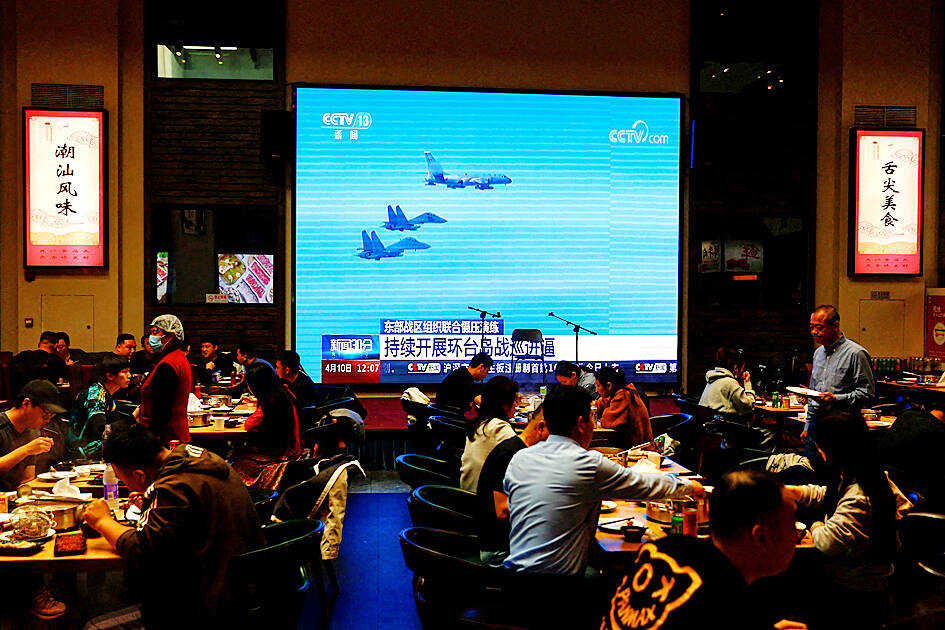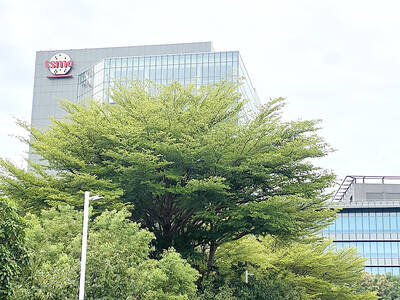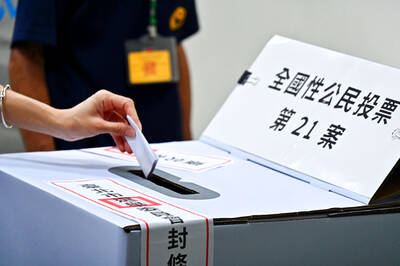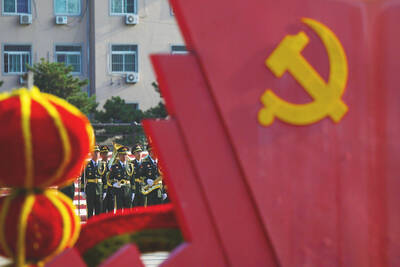A potential crisis across the Taiwan Strait on Thursday was rated as one of the top threats to US interests for the fourth consecutive year by the US Council on Foreign Relations.
The Center for Preventive Action published the results of the Preventive Priorities Survey, which compiled assessments by US foreign policy experts on the likelihood and effects of 30 potential conflicts that could emerge or escalate this year.
A “severe cross-strait crisis” that would affect the US and neighboring countries triggered by Beijing’s increasing economic and military pressure on Taiwan, especially around the nation’s presidential and legislative elections on Saturday next week, was one of the eight contingencies rated as “Tier I (High Priority)” in the report.

Photo: Reuters
The likelihood of such a crisis is “moderate,” but its effect on US interests would be “high,” the report said.
A high impact on US interests refers to a contingency that would directly threaten the US homeland, a defense treaty ally or a vital strategic interest, and “thus is likely to trigger a US military response,” it said.
The annual report rated possible conflicts between the US and China over Taiwan as a “Tier II (Medium Priority)” threat for its assessments in 2019 and 2020.
As tensions between Washington and Beijing intensified and the frequency of Chinese military activities near Taiwan increased, the situation was classified as a “Tier I” risk for the first time in 2021.
The growing risks of armed conflict with Russia and China are “by far the most worrisome” threats to the US, council director Paul Stares said.
“The trend toward less armed conflict around the world since the end of the Cold War is now moving in the opposite direction,” he said.
Three contingencies were rated as highly likely and having a high impact on US interests — “an unprecedented number” since the survey was launched in 2008, the report said.
Among the three, the possibility of growing political polarization leading to acts of domestic terrorism and political violence in the US was listed as the situation of most concern for the first time in 16 years, it said.
The other two were an expansion of the war between Hamas and Israel, and a surge of immigration to the US driven by criminal violence, corruption and economic hardship in Central America and Mexico, it said.
Other Tier I threats — which were all judged to be moderately likely and high-impact — were an escalation of the war in Ukraine, direct military confrontation between Iran and Israel, a highly disruptive cyberattack on critical infrastructure in the US and a security crisis in northeast Asia triggered by North Korea, it said.
The survey was conducted in November last year, receiving about 500 responses from US government officials, foreign policy experts and academics, it said.

Taiwan Semiconductor Manufacturing Co (TSMC, 台積電) is expected to start construction of its 1.4-nanometer chip manufacturing facilities at the Central Taiwan Science Park (CTSP, 中部科學園區) as early as October, the Chinese-language Liberty Times (the Taipei Times’ sister newspaper) reported yesterday, citing the park administration. TSMC acquired land for the second phase of the park’s expansion in Taichung in June. Large cement, construction and facility engineering companies in central Taiwan have reportedly been receiving bids for TSMC-related projects, the report said. Supply-chain firms estimated that the business opportunities for engineering, equipment and materials supply, and back-end packaging and testing could reach as high as

CHAMPIONS: President Lai congratulated the players’ outstanding performance, cheering them for marking a new milestone in the nation’s baseball history Taiwan on Sunday won their first Little League Baseball World Series (LLBWS) title in 29 years, as Taipei’s Dong Yuan Elementary School defeated a team from Las Vegas 7-0 in the championship game in South Williamsport, Pennsylvania. It was Taiwan’s first championship in the annual tournament since 1996, ending a nearly three-decade drought. “It has been a very long time ... and we finally made it,” Taiwan manager Lai Min-nan (賴敏男) said after the game. Lai said he last managed a Dong Yuan team in at the South Williamsport in 2015, when they were eliminated after four games. “There is

POWER PLANT POLL: The TPP said the number of ‘yes’ votes showed that the energy policy should be corrected, and the KMT said the result was a win for the people’s voice The government does not rule out advanced nuclear energy generation if it meets the government’s three prerequisites, President William Lai (賴清德) said last night after the number of votes in favor of restarting a nuclear power plant outnumbered the “no” votes in a referendum yesterday. The referendum failed to pass, despite getting more “yes” votes, as the Referendum Act (公民投票法) states that the vote would only pass if the votes in favor account for more than one-fourth of the total number of eligible voters and outnumber the opposing votes. Yesterday’s referendum question was: “Do you agree that the Ma-anshan Nuclear Power Plant

Democratic nations should refrain from attending China’s upcoming large-scale military parade, which Beijing could use to sow discord among democracies, Mainland Affairs Council Deputy Minister Shen You-chung (沈有忠) said. China is scheduled to stage the parade on Wednesday next week to mark the 80th anniversary of Japan’s surrender in World War II. The event is expected to mobilize tens of thousands of participants and prominently showcase China’s military hardware. Speaking at a symposium in Taichung on Thursday, Shen said that Chinese Minister of Foreign Affairs Wang Yi (王毅) recently met with Indian Prime Minister Narendra Modi during a visit to New Delhi.